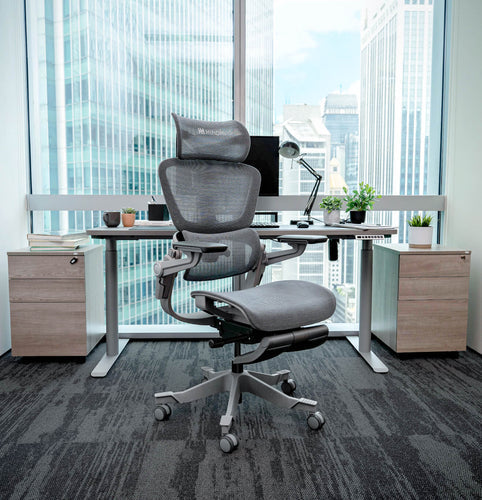
How to Choose the Perfect Ergonomic Chair for Your Home Office
Share
How to Choose the Perfect Ergonomic Chair for Your Home Office
Creating a comfortable and productive home office setup is essential for maintaining good posture and reducing the risk of musculoskeletal disorders. One of the key elements of an ergonomic home office is a well-designed chair that provides proper support and promotes a healthy sitting position. In this two-part article, we will explore the key factors to consider when selecting the perfect ergonomic chair for your home office.
Understanding the Importance of Ergonomics
Before diving into the factors to consider when choosing an ergonomic chair, it's important to understand why ergonomics matter. Ergonomics is the science of designing and arranging the workplace to fit the worker, with the aim of maximizing comfort, productivity, and overall well-being. When it comes to a home office setup, an ergonomic chair plays a crucial role in maintaining good posture and reducing strain on the body.
- Adjustability: Look for a chair that offers multiple adjustable features, such as seat height, armrest height and width, backrest angle, and lumbar support. The ability to customize the chair to your unique body shape and size is essential for achieving optimal comfort.
- Support: A good ergonomic chair should provide adequate support to the lower back (lumbar region) and the natural curve of the spine. Look for chairs with built-in lumbar support or adjustable lumbar pads to ensure proper alignment and reduce the risk of lower back pain.
- Seat Depth and Width: The seat should be deep enough to allow for proper thigh support, with at least two inches of space between the edge of the seat and the back of your knees. The width of the seat should also be appropriate for your body size, allowing you to sit comfortably without feeling restricted.
- Material and Cushioning: Consider the material and cushioning of the chair to ensure both comfort and durability. Look for chairs with breathable and easy-to-clean upholstery, such as mesh or fabric. The cushioning should be firm enough to provide support, but not too hard that it becomes uncomfortable after long periods of sitting.
- Mobility: Depending on your work style and preferences, consider whether you need a chair with wheels or a swivel base. Having the ability to move and rotate easily can enhance productivity and reduce strain on the body.
- Budget: Finally, consider your budget when selecting an ergonomic chair. While it's important to invest in a chair that prioritizes comfort and support, there are options available at various price points. Set a budget that aligns with your needs and explore different brands and models within that range.
Selecting the perfect ergonomic chair for your home office involves considering factors such as adjustability, support, seat depth and width, material and cushioning, mobility, and budget. By prioritizing these key factors, you can create a comfortable and productive workspace that promotes good posture and overall well-being. Stay tuned for Part 2, where we will provide additional tips and recommendations for choosing the perfect ergonomic chair for your home office setup.
Factors to Consider When Selecting an Ergonomic Chair
Now that we understand the importance of ergonomics, let's explore the key factors to consider when selecting an ergonomic chair for your home office:
- Adjustability: Look for a chair that offers multiple adjustable features, such as seat height, armrest height and width, backrest angle, and lumbar support. The ability to customize the chair to your unique body shape and size is essential for achieving optimal comfort.
- Support: A good ergonomic chair should provide adequate support to the lower back (lumbar region) and the natural curve of the spine. Look for chairs with built-in lumbar support or adjustable lumbar pads to ensure proper alignment and reduce the risk of lower back pain.
- Seat Depth and Width: The seat should be deep enough to allow for proper thigh support, with at least two inches of space between the edge of the seat and the back of your knees. The width of the seat should also be appropriate for your body size, allowing you to sit comfortably without feeling restricted.
- Material and Cushioning: Consider the material and cushioning of the chair to ensure both comfort and durability. Look for chairs with breathable and easy-to-clean upholstery, such as mesh or fabric. The cushioning should be firm enough to provide support, but not too hard that it becomes uncomfortable after long periods of sitting.
- Mobility: Depending on your work style and preferences, consider whether you need a chair with wheels or a swivel base. Having the ability to move and rotate easily can enhance productivity and reduce strain on the body.
- Budget: Finally, consider your budget when selecting an ergonomic chair. While it's important to invest in a chair that prioritizes comfort and support, there are options available at various price points. Set a budget that aligns with your needs and explore different brands and models within that range.
By considering these factors, you can choose an ergonomic chair that is tailored to your specific needs and preferences. Remember, a comfortable and supportive chair is essential for creating a productive home office setup that promotes good posture and overall well-being.
